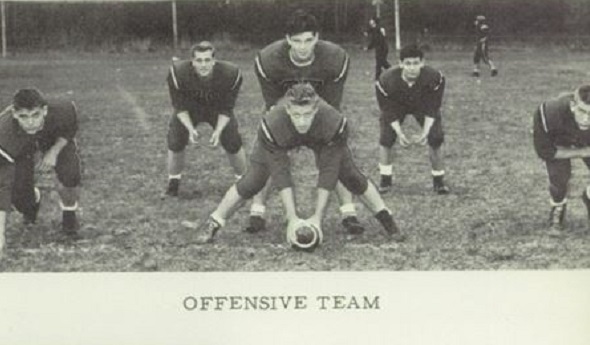
Epler's 6, 8-Player Game Lives On
November 10, 2017
By Ron Pesch
Special for Second Half
Is it a coincidence that the Stephen E. Epler Residence Hall on the campus of Portland State University is a six-story building?
Constructed in 2003 in the heart of downtown Portland, Oregon, the 130-unit structure is a belated tribute to Epler, “the founder of the Vanport Extension Center — the beginning of today's Portland State University.”
Following World War II, Epler moved to Portland with his wife Ferne to take a job counseling returning veterans on their educational opportunities. Once in the position, Epler quickly “realized that few colleges had the housing and jobs needed for the flood of veterans who wanted to take advantage of the GI Bill,” according to Bryce Henry, writing for The Oregon Encyclopedia, a project of the Oregon Historical Society.
To meet the needs of the area, he proposed “a two-year ‘feeder’ college. Established in March 1946 by the State Board of Higher Education, within 86 days, Epler had secured buildings at an old shipyard in Vanport and assembled a teaching staff into a college with housing. The Center allowed those veterans to begin work on achieving a college degree. For the next 10 years, Epler did all he could to nurse the Center he had helped create as it sought success and recognition.
 In 1952, after a series of physical moves around the Portland area, the Center was relocated to a site downtown and renamed Portland State Extension Center. Despite his work, Epler was passed over by the Oregon State Board as Dean. In 1955, with the announcement creating Portland State College by the Oregon state legislature, he was again passed over by the Board when they named a college president.
In 1952, after a series of physical moves around the Portland area, the Center was relocated to a site downtown and renamed Portland State Extension Center. Despite his work, Epler was passed over by the Oregon State Board as Dean. In 1955, with the announcement creating Portland State College by the Oregon state legislature, he was again passed over by the Board when they named a college president.
"’It was a blue day for me,’ Epler wrote in his diary,” wrote Charles White in a biography also written for the Encyclopedia. “With no administrative role in the new college, Epler accepted the presidency of Reedley College in California, where he served for five years. He then served as president of the prestigious College of Marin.
“Epler was fondly remembered by students who attended the Vanport and Portland Extension Centers, and in 1995, Portland State University honored him in a celebration of the school's origins,” continued White, a former professor at Portland State. “PSU feted its founder, dedicated the ‘Vanport Room,’ made him a PSU professor emeritus, and (later) named its new dormitory Stephen Epler Hall.”
The recognition for Epler, who passed away in 1997, was long overdue. Still, it wasn’t the first time Epler’s accomplishments had been celebrated. In what may have seemed a lifetime ago, he was honored on multiple occasions for an earlier creation.
~~~~~~~~~~~~~~~~~~
Born in 1909 in Brooklyn, Iowa, Epler was the son of a Disciples of Christ pastor and later played football at Cotner College in Lincoln, Nebraska. Following graduation, he taught for a year at Lincoln Teachers’ College High School. In 1934, he was working as a science and physical education instructor at Chester High School in Nebraska. On a rainy Saturday in the spring of 1934, an informal chat with Dean Moomey, the superintendent of Chester Public Schools, would alter the life path of both Epler and thousands of others.
The conversation was about football, or the lack of it at Chester, a school located on the Nebraska-Kansas border. “I was loyally defending football and giving reasons why every high school should play it,” recalled Epler, “but Mr. Moomey was reminding me of the actual situation in the small school and the sad experiences Chester and other small schools had … with the game in the past.”
Moomey identified two primary problems at play in Nebraska and beyond. Organizing a football team was a challenge because of expense, as outfitting “twenty-two or more players needed for a squad” was a burden for a small district, “when the gate receipts alone would hardly pay the official’s fee.” Funding was a major burden for small farming communities, compounded by a nation that was slowly working its way out of the Great Depression.
An even greater area of concern was for the safety of the players when a football team was formed. Squads from the smaller schools often included “lighter and weaker boys (competing) against players of vastly superior physical strength and stamina.” That, in turn, created worry and fear by parents about what might happen during a game, and certain disapproval if “their boy got hurt.”
In Nebraska at the time, more than 70 percent of the schools had enrollments of fewer than 100 pupils. Epler’s studies found that less than 19 percent could field a football team.
With Moomey’s encouragement and support, Epler settled on a goal of modifying the rules of the 11-man game he had played and loved to allow for “a safer, less expensive game, and one that required fewer players.”
 Later that year, Epler outlined the rules of six-man football, and on September 26, 1934, the first six-man football games were played at Hebron College. The contests featured a preliminary battle between Beatrice High and Hebron Academy that ended in a scoreless tie. A second match-up, staged between teams from Belvedere and Alexander High Schools and a squad representing Chester and Hardy schools, also ended in a deadlock, 19-19. “One of the officials at the (later) game was Mr. Epler himself, then coaching at Beatrice High School.”
Later that year, Epler outlined the rules of six-man football, and on September 26, 1934, the first six-man football games were played at Hebron College. The contests featured a preliminary battle between Beatrice High and Hebron Academy that ended in a scoreless tie. A second match-up, staged between teams from Belvedere and Alexander High Schools and a squad representing Chester and Hardy schools, also ended in a deadlock, 19-19. “One of the officials at the (later) game was Mr. Epler himself, then coaching at Beatrice High School.”
A crowd of around 1,000 attended the matchup, in which every man, with the exception of the center, was eligible for a pass. Epler’s game was played on a shortened field, 80 yards long and 40 yards wide. Playing time was to consist of four quarters, each eight minutes long. All players were to wear basketball or tennis shoes. While coaches of the two teams could allow exception, the rule was in place “to cut down the cost of equipping the team.” Instead of 10 yards in four downs, six-man football required a team to gain 15 yards in four attempts “to balance the increased offensive power that comes with the smaller number of players.” Also in place was a rule that required the player who received the ball from center to make a pass behind the line of scrimmage of not less than two yards forward or backward to another player, before the ball could be advanced.
A field goal was worth four points, while a point after touchdown was worth two if kicked, but only one if passed or run into the end zone. Goal posts were set 25 feet apart instead of 18, with a cross-bar mounted lower to encourage field goals and kicked extra points.
The news of this new version of the game was carried by wire services in newspapers nationally. Suddenly, “the terms ‘football team’ and ‘the eleven’” were no longer synonymous in the world of sports.
~~~~~~~~~~~~~~~~~~
Epler’s first edition handbook on six-man football, numbering 64 pages, was published in 1935. In Michigan, the six-man game found immediate interest in the state’s northern-most region.
“As an answer to the curtailment of athletic funds and the question of attracting suitable material for a team, a drive is being made among smaller Upper Peninsula high schools to begin and to encourage ‘six-man’ football,” wrote the Bessemer Herald in May 1935. Channing High School coach A.J. Mautner approached Quinnesec, Felch, Amasa, Florence and Alpha about the possibility.
Knowledge continued to spread, aided by a September 1935 article by Epler in Scholastic Coach, mailed to nearly 100 percent of the nation’s high schools and colleges and aimed at coaches and athletic directors. The magazine was the first “to open its pages to six-man football.” Another Epler article, “A New Deal for Football” saw publication in October 1936 in Athletic Journal, another popular national publication targeting coaches. A September 1937 article in Detroit-based American Boy, the largest magazine for boys based on circulation, offered readers a copy of the official rule books for the game at a discount. Finally, in 1938, Epler’s book, Six-Man Football: The Streamlined Game, a 251-page book on the development of the game, its philosophy, fundamentals and style of play was published. It was dedicated “To the men and boys who organized and participated in the first game of six-man football played at Hebron, Nebraska, in 1934.”
~~~~~~~~~~~~~~~~~~
An alternative to both the 11-man and six-man games surfaced a couple months after the Hebron College contests. Little on the genealogy of the eight-man game has been documented, but, among the earliest records is one staged in Michigan between Morrice and Vernon High Schools.
Described in the Lansing State Journal as “a style of play designed to suit the smaller schools,” anyone interested in viewing the November 9, 1934, contest could attend free of an admittance fee. “Instead of the regulation 11,” wrote the State Journal, “each team will have but eight players. Two guards and one backfield will be eliminated from each team. The width of the field will be cut to 120 feet, the offensive team will be permitted but five men on the line of scrimmage and on kickoffs the receiving team must keep three men within five yards of the restraining line until the ball is kicked.”
 E.J. Hendershott, principal, coach and agriculture instructor at Morrice, was certainly one of the earliest proponents of an eight-man version. In May of 1935, he presented on the variations of the game at the annual University of Michigan football clinic at Yost Field House.
E.J. Hendershott, principal, coach and agriculture instructor at Morrice, was certainly one of the earliest proponents of an eight-man version. In May of 1935, he presented on the variations of the game at the annual University of Michigan football clinic at Yost Field House.
In early November of 1935, an eight-man contest between Kalamazoo-area schools Comstock and Schoolcraft was judged “a success.” Consideration of the eight-man game was kicked around among the Jackson County High School Coaches Association in January 1936. Upon his return from a trip through the Upper Peninsula in September 1937, MHSAA director Charles Forsythe said “he found smaller schools enthusiastic about ‘miniature’ teams which play with but six or eight men instead of the regulation eleven.”
“The purpose … is to make football available to a wider range of boys than is now the case,” added Forsythe. “It is not pass and touch football, nor is it soccer. … The injury hazards are not so great with the smaller number of players on the field. … However the game should not be undertaken unless proper equipment is made available and coaching facilities are up to standard.”
~~~~~~~~~~~~~~~~~~
After limited experimentation, it appears that Epler’s version of the game won out in Michigan.
Nationally, the first Six-Man Football Committee was formed in 1937 and the group made some alterations to the rules, including movement of kickoffs from the 20 yard line to the 30, the creation of a “clear pass” rule that eliminated the need to judge whether a pass behind the line of scrimmage had traveled at least two yards, and changes to the substitution of players.
Nationally, it was estimated that 586 schools were playing six-man ball. In Michigan, the number was around 12.
In 1938, the national Six-Man Football Committee again altered the rules, this time to make all players, including the center, eligible to receive a pass. That fall, three schools in the Battle Creek area – Augusta, W.K. Kellogg Agricultural in Gull Lake and Climax – adopted the six-man game. Each played the other two twice during the season, with Augusta emerging undefeated, outscoring its opponents 134 to 8 over the four games.
A national report noted increased popularity of the sport. A total of 1,082 high schools now played the six-man game, nearly twice the number estimated in 1937. Around 50 schools played the six-man game in Michigan in 1938, according to Forsythe.
 In 1939, the game again saw additional growth. In the Battle Creek area, Sherwood, Tekonsha, and Mendon joined Colon to form the St. Joseph Valley six-man football league. In addition, Climax, Schoolcraft, Richland, Scotts, Albion Starr Commonwealth, Sunfield, Martin and Marcellus took up the modified game. Reporting on the growing popularity, the Battle Creek Enquirer and News summed up the interest: “The scoring possibilities are numerous. … That’s what the fans like. Big Scores.”
In 1939, the game again saw additional growth. In the Battle Creek area, Sherwood, Tekonsha, and Mendon joined Colon to form the St. Joseph Valley six-man football league. In addition, Climax, Schoolcraft, Richland, Scotts, Albion Starr Commonwealth, Sunfield, Martin and Marcellus took up the modified game. Reporting on the growing popularity, the Battle Creek Enquirer and News summed up the interest: “The scoring possibilities are numerous. … That’s what the fans like. Big Scores.”
Colon, coached by W.H. Judd, was awarded the Enquirer and News Trophy as St. Joseph Valley grid champion that season.
The “Tom Thumb League”, a subset of the Central Thumb League, also was formed in 1939. Comprised of Ubly, Port Hope, Kinde, Port Austin, Peck, Carsonville, Bay Port, Owendale and Gagetown, it was designed to provide a football program for small schools in the Thumb area of the state. Five of the nine had previously played either 11-man or six-man football in the past. No standings were kept that first year.
Statewide, 450 schools competed in traditional 11-man football in 1939, while six-man continued to grow rapidly. According to press reports, 100 or more now played the Epler version in Michigan.
In Fennville, coach Carson Niefert’s 1939 team notched an impressive 7-1 mark while jockeying between both versions of the game. Five wins came against six-man squads while the Blackhawks finished 2-1 in 11-man contests, downing both Hartford and Otsego. Their only loss came against Ravenna in the season opener. Due to a misunderstanding, Fennville was prepared to play a six-man game, but agreed to an 11-man game when the visitors arrived ready to play the standard version.
In the Lansing area, after a three-year lapse in which no football was played at Haslett High School, a six-man squad was assembled. Contests with other small schools including Bath, Morrice, Vernon, Byron, and Laingsburg were scheduled.
~~~~~~~~~~~~~~~~~~
In 1940, the MHSAA reported 150 schools across Michigan played six-man football. Schoolcraft and Climax were added to the St. Joseph Valley League. Colon emerged as the league’s sole champion. The conference title had been shared by Colon, Sherwood and Mendon in 1939.
The Central Thumb League and Thumb Tip League consolidated, and had shrunk to six schools playing football, as Port Austin dropped the sport, while Peck and Carsonville left the league. Ubly was honored as champion with a perfect 7-0 record.
Haslett, under the guidance of coach Paul Moyes, began its second year of six-man competition in 1940. In 1941 the Tri-County League was formed, comprised of Haslett, Bath, Morrice, Vernon, Byron, Laingsburg, DeWitt and the Michigan School for the Blind. Bath emerged as champions that season.
Augusta and Gull Lake W.K. Kellogg were added to the St. Joseph Valley in 1941, bringing that league total to eight teams.
Marenisco High School, coached by Joseph Poisson of Iron Mountain, claimed the “undisputed six-man football championship” of the Upper Peninsula in 1941. Undefeated in six games, his team averaged 51 points per contest.
Another successful six-man team from the era, according to the Detroit Free Press, was Roscommon, which had lost a single game from 1938 to 1941.
Travel restrictions and product rationing impacted high school sports around the state during the war years. Petersburg downed Britton in the final game of the 1942 season, wrestling away the Raisin Valley six-man football championship for the first time. Britton had won the league crown the previous two seasons. The teams would share the league crown in 1943.
 Climax grabbed its sixth straight St. Joseph Valley win, its fifth by the league’s maximum score limit, with a 50-0 victory over Tekonsha on October 29, 1943. League rules ended games when a team’s point total equaled or exceeded 45. A week later, Climax traveled to Colon for a conference showdown of unbeaten and untied squads. Like Climax, Colon had dominated conference opponents during the season.
Climax grabbed its sixth straight St. Joseph Valley win, its fifth by the league’s maximum score limit, with a 50-0 victory over Tekonsha on October 29, 1943. League rules ended games when a team’s point total equaled or exceeded 45. A week later, Climax traveled to Colon for a conference showdown of unbeaten and untied squads. Like Climax, Colon had dominated conference opponents during the season.
Played under the lights before a crowd of 1,200, the largest in Colon history, the battle between the evenly-matched squads was a worthy finish to the season. A “safety by Ralph Slage of Colon, his second of the night, sent the invading Climax team into a two-point lead at 10 to 8, with four minutes of play remaining.” With eight seconds left on the clock, that two-point margin looked secure when Climax surrendered the ball on downs at the Colon 15-yard line.
“There was just time for one play. Climax arranged its defensive forces for an anticipated pass.” Instead, Colon back Elmer Saddison broke free from a mass of Climax defenders at the 15-yard line and raced 65 yards for the game-winning touchdown.
~~~~~~~~~~~~~~~~~~
In September 1945, the Lansing area Tri-County League reorganized to handle the three sports of baseball, basketball and six-man football. The circuit was now composed of Bath, Byron, Gaines, Haslett, Morrice and Laingsburg. The St. Joseph Valley reorganized, with Colon and W.K. Kellogg departing to play 11-man ball. Rechristened the Southwestern Michigan Six-Man League, Marcellus joined in 1946, Martin was added for two seasons, 1946 and 1947, Centrevillie was added in 1948 and Albion Starr Commonworth in 1949.
On Monday, November 11, 1946, Laingsburg, champion of the Tri-County league, represented Central Michigan against Burr Oak, winner of the Southwestern Michigan league, in what was billed as the state’s first “six-man state championship.” With the game staged on the lighted field at East Lansing High School, Dick Sparkes scored four times on runs of 30, 19, 18 and six yards to lead Laingsburg to a 33-26 win.
A year later a crowd of 700 at Mendon High School watched as Bath, the Tri-County champ coached by former Michigan State star halfback and captain, Walt Pawlowski, downed Climax, 36-20, in the second six-man championship game between the Central Michigan and Southwestern Michigan title winners.
Again the Bath squad won the Tri-County League title in 1948 and represented Central Michigan in the six-man championship series. The third title game was again hosted at East Lansing High School on Armistice Day. Victory came easily over Schoolcraft, the Southwestern League hopeful, 43-13. Bill Ballard and Forest Bass each scored three touchdowns in the rout.
In spite of the loss to Bath, the season was richly celebrated by Schoolcraft. Runner-up medals were awarded following the game, and later a steak dinner with all the trimmings was hosted at a banquet in Kalamazoo. There, coach Kenneth Krum’s squad celebrated the school’s first-ever Southwestern Conference football championship.
~~~~~~~~~~~~~~~~~~
One month before on October 7, 1948, Epler, a naval officer during World War II, flew back to Chester, Nebraska from his current home in Vanport, Oregon. He was the guest of honor brought back to celebrate the 15th anniversary of the game he created. A crowd of more than 1,000 fans was on hand to applaud his achievement.
“To make the celebration perfect,” stated The Lincoln Star, “the home-town Chester six-man team bounced undefeated Sacred Heart of Norfolk by a resounding score of 26-2.”
According to rival Lincoln newspaper, the Nebraska State Journal, “It was the first defeat in 22 games for the invading Knights. … Between the halves, Epler received a trophy from the community of Chester. In turn, he presented plaques to the coaches of the two teams. …Governor (Val) Peterson, a former football coach himself, braved the weather to view the entire game.”
Earlier in the day, Governor Peterson greeted Epler, calling him a “man of vision” and “presented him an admiralty in the Nebraska ‘navy’.”
~~~~~~~~~~~~~~~~~~
“Is Eight-Man Football Preferable to the Six-Man Game?” asked an article in the Athletic Journal in 1942. Nationally, eight-man football had started to take hold, at the expense of six-man, especially in mid-sized schools during the late 1940s and early 1950s.
 Back in Michigan, the 1949 season saw a marked decrease in six-man ball, as around 50 schools in the state still played Epler’s version of the game.
Back in Michigan, the 1949 season saw a marked decrease in six-man ball, as around 50 schools in the state still played Epler’s version of the game.
Bath again finished 1949 undefeated and was now riding a 21-game win streak. Mendon ended the year unbeaten and untied in seven games, outscoring its opponents by a 262 to 112 margin. Plans for another “six-man championship” contest were made, but, as Bill Tucker, center for the Bath squad recalled in 2007, Bath’s coach Pawlowski sat the team down and announced no title game would be played.
“It was heartbreaking,” Tucker told Lansing State Journal reporter Chris Solari. “(Mendon’s coaches) said they were tired of playing football. I’ll tell you what – we’d have whomped them, anyway.”
The 1950 season saw the formation of the Cherryland Class D Conference, comprised of Leland, Suttons Bay, Lake Leelanau St. Mary, Empire, Williamsburg and Kingsley. New arrangements were made for a mythical six-man state title contest, pitting the Tri-County Class D champion against Lake Leelanau St Mary, the Northern Michigan champ. Laingsburg won the game, played at Clare High School, 34-12. Laingsburg and the rest of the Tri-County League moved to 11-man ball in 1951.
At Elk Rapids, Bellaire, Bergland, Ewen, Mercer, and Ironwood St. Ambrose, Epler’s game endured several more years. According to press reports, St. Ambrose scored four undefeated seasons of six-man ball between 1942 and 1947, before discontinuing the sport following the 1951 season. It was revived in 1954 for three additional campaigns before stopping again.
~~~~~~~~~~~~~~~~~~
In 1950, Freeport High School played its first-ever football game – the eight-man version. The season opener was a loss to Schoolcraft, 46-19, but the team managed a 3-6 record in games with the Hastings reserve team, Parnell, Rogers, Gaines and Sand Lake. (Freeport jumped to 11-man football in 1951). Schoolcraft, Mendon and the rest of the Southwestern Michigan league also played eight-man football in 1950, and then moved to the traditional 11-man game in 1955. In the Upper Peninsula, Bessemer and others districts experimented with eight-man ball at the junior high level.
The 1952 season saw six-man competition continue to drop off around the state. Still, in northern Michigan, the game remained. At Sault Ste. Marie Loretto, the Little Eight Conference six-man schedule called for six contests with the other Class D membership, as games were scheduled with Grand Marais, DeTour, Brimley, Cedarville, Rudyard and 1951 league champion Pickford. Loretto hoped to arrange an 11-man game against St. Ignace, also a member of the Little Eight, late in the season. According to Herb Levin of the Sault Ste. Marie Evening News, St. Ignace, with a Class C enrollment, was the first league member to attempt a move to the traditional game, scheduling a slate of opponents comprised of “reserve teams from Class C and Class B in Upper Peninsula and lower Michigan. If the venture into the ranks of 11-man ball is successful, several other conference schools may follow within the next few years.”
It appears most of the Little Eight moved to eight-man ball in 1959, then 11-man in 1961.
~~~~~~~~~~~~~~~~~~
Cheboygan Catholic earned at least a share of the Northern Michigan six-man football league crown in 1952 as well. The sole winner of the league in 1950, the team shared the league championship with Bellaire in 1951 and with Elk Rapids in 1952.
An attempt to move to six-man ball by Class D schools from Pentwater, Freesoil, Holton, Custer and Ludington St. Simon in western Michigan lost steam before the 1954 season.
Thanks to the baby boom and increased enrollments, the resulting growth of the suburbs, and the expanding consolidation of smaller rural schools around the state, the coming years would see rapid decline in both six and eight-man squads. With the 1960 season, the Northern Six Football Conference operated as the last six-man league in the state. Bellaire won the conference, comprised of Central Lake, Ellsworth, Frederic, Indian River Inland Lakes, Mackinaw City and Vanderbilt, all Class D schools.
That lasted until 1964, when the league moved to eight-man ball, then to 11-man in 1968.
The Wolverine Conference, comprised of Rock, Carney, Bark River-Harris and Powers-Spalding, switched from regulation 11-man football to 8-man football in 1961, and was the last in the U.P. to play that style of ball. In 1962, Carney dropped from the league for financial reasons, as football was not paying for itself. It was replaced in the league by Pembine, “a Marinette County school in Wisconsin.” The league continued playing eight-man through the 1971 season.
~~~~~~~~~~~~~~~~~~
Like in Michigan, the six-man game had died out in Nebraska in the 1960s.
 In October 1991, “as the last rays of sunlight disappeared across the plains, the mighty starting six of the Chester-Hubbell-Byron Consolidated High School Bulldogs squared off against the starting six of the hated visiting Campbell Cardinals,” penned Los Angeles Times staff writer Bob Sector. Describing the resurgence of the game, rediscovered thanks to dwindling enrollments across the country, he discussed its origins with Epler, who had returned at age 82 to be honored at a special halftime ceremony.
In October 1991, “as the last rays of sunlight disappeared across the plains, the mighty starting six of the Chester-Hubbell-Byron Consolidated High School Bulldogs squared off against the starting six of the hated visiting Campbell Cardinals,” penned Los Angeles Times staff writer Bob Sector. Describing the resurgence of the game, rediscovered thanks to dwindling enrollments across the country, he discussed its origins with Epler, who had returned at age 82 to be honored at a special halftime ceremony.
“The six-man game gave the high school students something to do,” said Epler to Sector, “and they could stay at their own schools and they could have all the bands and pep rallies just like the big schools.”
Chester junior Thad Mumm started the game with a highlight, returning “the opening kickoff for a 78-yard touchdown.” Mumm was the “grandson of Garald Van Winkle, who played in Epler’s groundbreaking six-man game,” back in 1934. Unfortunately, the home team fell this time, 26-20 in overtime.
Those dwindling enrollments have brought six-man to five states according to the National Federation of State High School Associations, including Texas, where it was first played in 1936 and has continued uninterrupted. More than 130 schools play Epler’s game in the Lone Star state today.
The 8-player game is now played in 18 states, including Michigan. It returned to the MHSAA-sponsored high school sports menu in 2010, with its first playoffs in 2011. Michigan 8-player football now is played by more than 60 schools, with the first two-division Finals scheduled for Nov. 18 at the Superior Dome at Northern Michigan University.
 Ron Pesch has taken an active role in researching the history of MHSAA events since 1985 and began writing for MHSAA Finals programs in 1986, adding additional features and "flashbacks" in 1992. He inherited the title of MHSAA historian from the late Dick Kishpaugh following the 1993-94 school year, and resides in Muskegon. Contact him at [email protected] with ideas for historical articles.
Ron Pesch has taken an active role in researching the history of MHSAA events since 1985 and began writing for MHSAA Finals programs in 1986, adding additional features and "flashbacks" in 1992. He inherited the title of MHSAA historian from the late Dick Kishpaugh following the 1993-94 school year, and resides in Muskegon. Contact him at [email protected] with ideas for historical articles.
PHOTOS: (Top) Bellaire's six-man offense lines up for a photo in 1960. (Middle 1) Stephen Epler, from a 1935 newspaper report. (Middle 2) A poster announces the “first six-man football game in the U.S.A.” to be played in Nebraska. (Middle 3) The Lansing State Journal advertised a “state championship” game between Laingsburg and Burr Oak in 1946. (Middle 4) Bath High School displays its championship trophies won during the six-man heyday. (Middle 5) The Schoolcraft 1948 six-man team. (Middle 6) The Bellaire yearbook celebrated its 1960 Northern Six Football Conference championship team. (Below) Stephen Epler, from the Nebraska Hall of Fame. (Special thanks to Tom Townsend, Bath schools’ Denise Wahrer and library staff at Central Michigan University for providing background, photos and resources used in this piece.)
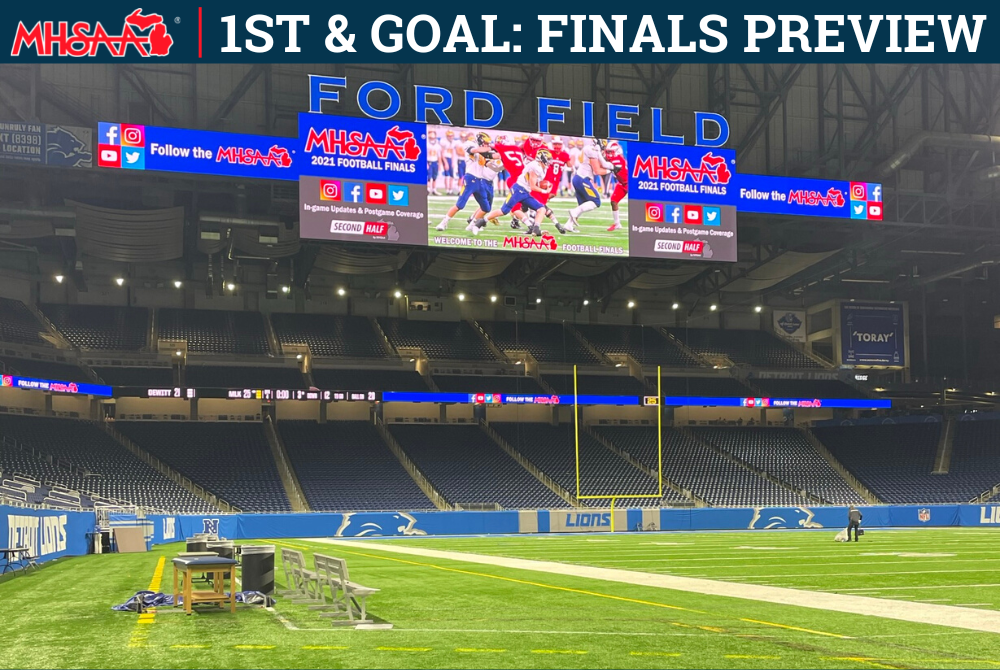
1st & Goal: 2022 11-Player Finals Preview
By
Geoff Kimmerly
MHSAA.com senior editor
November 23, 2022
We like to say every score has a story, and this weekend's 11-Player Football Finals at Ford Field have foundations laid for many to be told.
 The Division 1 and 2 matchups feature reigning champions against opponents returning to the Finals for the first time in a decade or more. The Division 5 and 8 games pit undefeated teams, with three of the four seeking their first championship at this level. The Division 3 and 7 games are rematches of powerhouse-packed playoff rivalries. The Division 4 and 6 games feature former Finals mainstays making their returns, but against teams looking to start their own traditions of traveling to Detroit for the holiday weekend. And the list goes on and on.
The Division 1 and 2 matchups feature reigning champions against opponents returning to the Finals for the first time in a decade or more. The Division 5 and 8 games pit undefeated teams, with three of the four seeking their first championship at this level. The Division 3 and 7 games are rematches of powerhouse-packed playoff rivalries. The Division 4 and 6 games feature former Finals mainstays making their returns, but against teams looking to start their own traditions of traveling to Detroit for the holiday weekend. And the list goes on and on.
Here's the schedule for Friday and Saturday's games:
Friday, Nov. 25
Division 8 – Ottawa Lake Whiteford (13-0) vs. Ubly (13-0) – 10 a.m.
Division 2 – Grand Rapids Forest Hills Central (13-0) vs. Warren De La Salle Collegiate (12-1) – 1 p.m.
Division 6 – Grand Rapids West Catholic (12-1) vs. Negaunee (13-0) – 4:30 p.m.
Division 4 – Grand Rapids South Christian (13-0) vs. Goodrich (12-1) – 7:30 p.m.
Saturday, Nov. 26
Division 7 – Traverse City St. Francis (13-0) vs. Jackson Lumen Christi (10-3) – 10 a.m.
Division 1 – Belleville (13-0) vs. Caledonia (12-1) – 1 p.m.
Division 5 – Frankenmuth (13-0) vs. Gladwin (13-0) – 4:30 p.m.
Division 3 – Muskegon (11-2) vs. Detroit Martin Luther King (9-3) – 7:30 p.m.
All games will be broadcast live on Bally Sports Detroit’s primary channel except the Division 4 Final, which will be broadcast on the Bally Sports Detroit website and Bally Sports app, and Stadium College Sports. Additionally, all eight championship games will be available for listening from the MHSAA Network at MHSAANetwork.com.
Below is a glance at all eight matchups. Statistics are through Semifinals unless noted.
Division 1
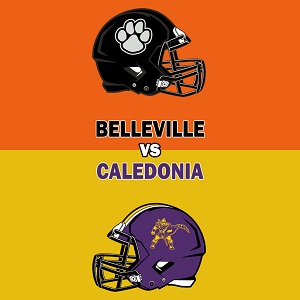 BELLEVILLE
BELLEVILLE
Record/rank: 13-0, No. 1
Coach: Dejuan Rogers, interim coach (4-0)
League finish: First in Kensington Lakes Activities Association East and overall
Championship history: Division 1 champion 2021.
Best wins: 29-28 (OT) over Detroit Cass Tech in Semifinal, 33-10 over No. 10 (tie) Detroit Catholic Central in Regional Final, 62-44 over Saline in District Final, 42-3 over No. 10 (tie) Brighton, 42-14 over Division 2 No. 3 Livonia Franklin.
Players to watch: QB Bryce Underwood, 6-2/180 soph. (2,599 yards/35 TDs passing, 478 yards/7 TDs rushing); RB/LB Jeremiah Beasley, 6-1/215 jr. (1,177 yards/23 TDs rushing); RB Colbey Reed, 5-9/210, jr. (462 yards/9 TDs rushing); DL Jeremiah Warren, 6-3/285, sr.
Outlook: The Tigers bring a 24-game winning streak into this Final, with Cass Tech last week the only team to come within single digits of matching them. Underwood is considered one of the top sophomores nationally, and he showed why in leading Belleville’s comeback win over the Technicians with two touchdowns rushing and another passing. He was The Associated Press’ Division 1-2 all-state Player of the Year as a freshman, while junior defensive back James Robinson also made the first team and Warren, junior receiver/safety Jalen Johnson, senior defensive lineman Camden Weaver, Beasley and senior receiver/defensive back Mychal Yharbrough earned honorable mentions. Junior offensive lineman Nathaniel Johnson (6-5/330) is another highly-regarded talent.
CALEDONIA
Record/rank: 12-1, No. 8
Coach: Derek Pennington, second season (22-3)
League finish: Second in Ottawa-Kent Conference Red
Championship history: Division 3 champion 2005.
Best wins: 14-13 (2OT) over No. 3 Rockford in District Final, 21-0 over No. 7 Clarkston in Semifinal, 48-26 (District Semifinal) and 50-40 over Grandville, 42-14 over Grand Ledge in Regional Final.
Players to watch: RB/DB Brock Townsend, 6-0/200 RB/DB jr. (1,179 yards/17 TDs rushing, 5 interceptions); QB Mason McKenzie, 6-0/180 sr. (1,375 yards/20 TDs passing, 1,537 yards/19 TDs rushing); HB/LB Derek Pennington Jr., 6-2/225 jr. (308 yards/5 TDs receiving); OL/DL Carlo Aybar, 6-1/275 sr.
Outlook: The Fighting Scots have shown remarkable resilience over the last month, bouncing back from a 38-15 loss to Rockford in Week 9 to rumble back to the Finals – with their best win arguably a 14-13 victory over the Rams only two weeks after the defeat, although the shutout of Clarkston clearly was noteworthy as well. A strong running attack long has been the name of Caledonia’s game, and the Fighting Scots went over 3,400 yards and 45 touchdowns rushing in the Semifinal win. Last week’s also was their fifth shutout of the season, but really the last three weeks have seen some of the team’s most impressive performances on that side of the ball as Rockford was averaging 37 points per game, Grand Ledge was averaging 30 and Clarkston was averaging 41.
Division 2
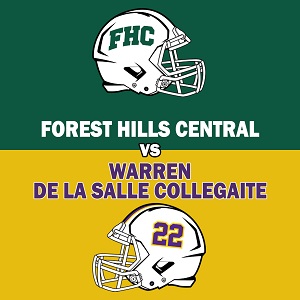 GRAND RAPIDS FOREST HILLS CENTRAL
GRAND RAPIDS FOREST HILLS CENTRAL
Record/rank: 13-0, No. 4
Coach: Tim Rogers, 11th season (76-39)
League finish: First in O-K White
Championship history: Class A runner-up 1994.
Best wins: 20-17 (2OT) over No. 1 Dexter in Semifinal, 31-21 over No. 7 Muskegon Mona Shores in District Final, 21-17 over East Lansing in Regional Final, 21-13 over Byron Center.
Players to watch: WR/DB Ty Hudkins, 6-0/182 jr. (843 yards/10 TDs receiving); DB/QB Mason McDonald jr. (355 yards/6 TDs passing, 374 yards/2 TDs rushing); LB/RB JT Hartman jr. (941 yards/8 TDs rushing); DL/OL Crandall Quinn, 6-2/235 sr. (Statistics through Regional Finals.)
Outlook: The Rangers have pulled through one-score games the last two weeks with a defense that’s given up 8.6 points per game on the season and hasn’t backed down against the tougher competition of the playoffs – seeing that average rise to only 15 ppg over four postseason games. Quinn and senior linebacker Raymond Cargill are among the pacesetters of that group. McDonald has stepped in admirably at quarterback the last two weeks – he threw and ran for another touchdown in the Dexter win – after senior Justin Osterhouse (654 yards/15 TDs rushing, 1,070 yards/13 TDs passing) was reportedly on crutches following the District Final.
WARREN DE LA SALLE COLLEGIATE
Record/rank: 12-1, No. 2
Coach: Dan Rohn, third season (32-6)
League finish: Tied for first in Detroit Catholic League Central
Championship history: Four MHSAA titles (most recent 2021), three runner-up finishes.
Best wins: 37-7 over No. 9 Roseville in District Final, 28-0 over Division 1 No. 10 (tie) Detroit Catholic Central, 19-18 over Division 3 No. 4 River Rouge, 49-16 over Division 3 No. 7 Muskegon.
Players to watch: QB/DB Brady Drogosh, 6-4/215 sr. (1,839 yards/33 TDs passing, 1,088 yards/13 TDs rushing); RB/LB Rhett Roeser, 6-0/225 jr. (727 yards/13 TDs rushing); DL/TE Mason Muragin, 6-3/240 sr. (71 tackles/14.5 sacks); LB/TE James McDonald, 6-1/220 sr. (115 tackles/17 tackles for loss).
Outlook: The Pilots navigated another strong regular-season schedule with their only loss by a point to Bloomfield Brother Rice, and that’s no doubt paid off as they’ve been unchallenged during the playoffs outscoring their four opponents by a combined 175-29. Drogosh, who will continue at Cincinnati, made the all-state first team as a junior, while Muragin – playing next at Illinois – earned an honorable mention last season. Defensive back Jamari Allen is committed to continue at Central Michigan. Senior receivers Jack Yanachik (523 yards/8 TDs receiving) and Triston Nichols (449/8) are among top Drogosh targets.
Division 3
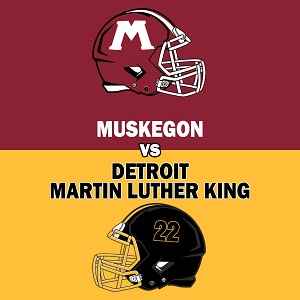 MUSKEGON
MUSKEGON
Record/rank: 11-2, No. 7
Coach: Shane Fairfield, 13th season (142-26)
League finish: Tied for first in O-K Green
Championship history: Six championships (most recent 2017), six runner-up finishes.
Best wins: 27-20 over No. 6 Zeeland West in Regional Final, 49-21 over No. 9 DeWitt in Semifinal, 55-35 over Division 2 No. 7 Muskegon Mona Shores, 28-20 over Muskegon Reeths-Puffer.
Players to watch: QB/DB M’Khi Guy, 5-9/155 jr. (1,638 yards/24 TDs rushing, 647 yards/11 TDs passing); SL/DB Destin Piggee, 5-7/160, sr. (718 yards/5 TDs rushing, 351 yards/5 TDs receiving); RB/LB Jakob Price, 5-7/175 jr. (971 yards/14 TDs rushing); OL/DL D’Andre Hudgins, 6-3/285 sr.
Outlook: The Big Reds are making a familiar trip back to Ford Field for the first time since 2019, featuring familiar strengths – multiple playmakers including a tough-to-tackle running quarterback, and a giant line leading the way. Hudgins is joined by three more linemen 6-4 or 6-5, with two of those at 300 or more pounds. Guy ran for more than 300 yards and six touchdowns against DeWitt, and Price and Piggee stretch defenses as well – all three were averaging at least seven yards per carry entering last weekend. The losses came Week 2 to Division 2 finalist Warren De La Salle and Week 5 to Zeeland West, the latter avenged in the Regional Final. Price earned an all-state honorable mention last season.
DETROIT MARTIN LUTHER KING
Record/rank: 9-3, No. 1
Coach: Tyrone Spencer, seventh season (74-17)
League finish: Second in Detroit Public School League Blue
Championship history: Five MHSAA titles (most recent 2021), three runner-up finishes.
Best wins: 52-17 over No. 3 Mason in Semifinal, 22-12 over Bloomfield Hills Brother Rice in Regional Final, 41-28 over No. 4 River Rouge in District Semifinal, 28-23 over Detroit Cass Tech.
Players to watch: QB Dante Moore, 6-2/210, sr. (2,239 yards/28 TDs passing, 5 TDs rushing – includes Semifinal); WR/DB Jameel Croft Jr., 6-1/185 sr. (671 yards/8 TDs receiving, 6 interceptions); DE Kenny Merrieweather, 6-3/235, sr. (45 tackles, 16 tackles for loss, 12 sacks); RB Sterling Anderson Jr., 5-8/165, sr. (918 yards/12 TDs rushing). (Statistics through Regional Finals except Moore’s.)
Outlook: The reigning Division 3 champion will return with a star-studded cast, headlined by Moore as he finishes his four-year varsity career before continuing at Oregon. Anderson went over 1,000 yards rushing during the Semifinal win and scored six total touchdowns against Mason, while Croft snagged two more interceptions. Croft is committed to Kansas, Merrieweather is committed to Iowa and both joined Moore on the all-state first team last season, when Moore also was named Associated Press Division 3-4 Player of the Year. The Crusaders lost their final two games of the regular season, to Cass Tech and Cincinnati Moeller, but had only one single-digit game before (against Cass Tech) and none since.
Division 4
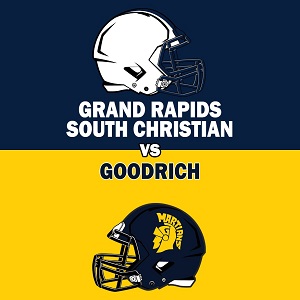 GRAND RAPIDS SOUTH CHRISTIAN
GRAND RAPIDS SOUTH CHRISTIAN
Record/rank: 13-0, No. 2
Coach: Danny Brown, fourth season (35-11)
League finish: First in O-K Gold
Championship history: Three MHSAA titles (most recent 2014), four runner-up finishes.
Best wins: 26-20 over No. 5 Edwardsburg in Semifinal, 28-21 over No. 1 Whitehall in Regional Final, 35-20 over Hudsonville Unity Christian in District Final, 36-34 over Division 1 No. 5 Grand Rapids Catholic Central.
Players to watch: QB/LB Jacob DeHaan, 6-2/190 sr. (2,574 yards/33 TDs passing, 1,128 yards/17 TDs rushing); WR/DB Seth Ritsema, 6-2/200 sr. (776 yards/10 TDs receiving); WR/RB Carson Vis, 6-3/180, soph. (659 yards/15 TDs receiving); OL/LB Cameron Post, 6-4/250 sr. (54.5 tackles/14.5 tackles for loss).
Outlook: South Christian is making its first Finals trip since that championship season in 2014, and after not only defeating two top-five teams in the playoffs but also downing last season’s Division 4 runner-up in Unity Christian. The regular-season win over GRCC ended the Cougars’ 41-game winning streak. DeHaan earned an all-state honorable mention last season as a junior, as did running back/kicker Nate Brinks (689 yards/8 TDs rushing, 60-64 XP/1 FG kicking). Senior linebacker Cayden Dykema (6-5/205) leads the defense with 77.5 tackles, plus has totaled 12.5 tackles for loss.
GOODRICH
Record/rank: 12-1, unranked
Coach: Tom Alward, 30th season (186-113)
League finish: First in Flint Metro League Stars
Championship history: Has never played in an MHSAA Final.
Best wins: 51-26 over No. 3 Riverview in Semifinal, 40-20 over Orchard Lake St. Mary’s in Regional Final, 10-9 over No. 6 Freeland in District Final, 42-21 over Almont.
Players to watch: QB/DB Gavin Hart, 6-3/180 sr. (1,732 yards/20 TDs passing); RB/LB Jace Simerson, 5-10/200 sr. (1,380 yards/20 TDs); WR/DB Caden Kolanowski, 6-1/180, sr. (622 yards/6 TDs receiving); TE/DE Jace Williams, 6-4/200, sr.
Outlook: Goodrich has won 12 straight games on the way to Ford Field after suffering its only loss Week 1 to Division 5 finalist Frankenmuth, and also set a program record for victories along the way. Only three of those wins were decided by a score or less, and Goodrich improved on a 6-0 win over Linden in Week 2 with a 21-0 shutout in a Week 8 rematch. Simerson ran for five touchdowns last weekend in the victory over previously-undefeated Riverview. Kolanowski earned an all-state honorable mention last season as a specialist; he’s kicked and connected on 50 of 51 extra-point attempts and four field goals this season. Junior linebacker Easton Phipps joins Williams in anchoring the defense.
Division 5
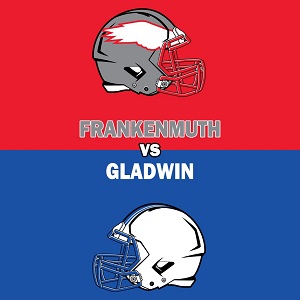 FRANKENMUTH
FRANKENMUTH
Record/rank: 13-0, No. 5
Coach: Phil Martin, 10th season (104-16)
League finish: First in Tri-Valley Conference 8
Championship history: Division 5 runner-up 2020.
Best wins: 38-0 over No. 7 Detroit Country Day in Semifinal, 49-7 over Flint Hamady in Regional Final, 21-0 over Division 4 No. 6 Freeland, 27-2 over Goodrich.
Players to watch: QB Aidan Hoard, 6-4/205 sr. (1,406 yards/18 TDs passing, 682 yards/11 TDs rushing); RB/LB Griffin Barker, 5-9/170 jr. (861 yards/14 TDs rushing); TE/DE Brenden Marker, 6-3/220 sr. (40 tackles/16 tackles for loss/8 sacks); RB/LB Dalton DeBeau, 6-0/220 sr. (79 tackles/23 tackles for loss).
Outlook: The Eagles are headed back to the Finals for the second time in three years in part driven by a defense that has given up 64 points this season – with two of their five shutouts coming over the last three playoff games. The most points Frankenmuth has given up is 16, to Saginaw Swan Valley in Week 2, and the Eagles shut out Swan Valley 31-0 in the District Final. Frankenmuth also has allowed 135 total yards per game this fall – and 317 rushing yards total over 13 games. Junior Colin Main is another impressive defender, with 69 tackles, 22 for loss and nine sacks. The Eagles spread the wealth offensively; Hoard has thrown a touchdown pass to 10 receivers, and senior Sam Barger is another reliable rusher with 717 yards and 11 touchdowns on the ground.
GLADWIN
Record/rank: 13-0, No. 2
Coach: Marc Jarstfer, fourth season (27-13)
League finish: First in Jack Pine Conference
Championship history: Has never played in an MHSAA Final.
Best wins: 28-21 over No. 1 Grand Rapids Catholic Central in Semifinal, 26-8 over No. 4 Muskegon Oakridge in Regional Final, 33-27 over No. 8 Pontiac Notre Dame Prep, 38-0 over Clare.
Players to watch: QB/S Nick Wheeler, 6-1/190 sr. (956 yards/11 TDs passing, 881 yards/19 TDs rushing, 57 tackles/5 interceptions); RB/LB Logan Kokotovich, 5-11/195 sr. (932 yards/13 TDs rushing, 84 tackles); SL/LB Earl Esiline, 5-10/170 sr. (1,073 yards/14 TDs rushing, 45 tackles); OL/DL Lincoln McKinnon, 6-2/240 sr.
Outlook: A long-anticipated senior class has made good in taking Gladwin on its first trip to the Finals, after the Flying Gs also claimed their first Jack Pine Conference title since sharing it in 2002. The win over GRCC last weekend ended the Cougars’ three-year Finals streak and earned Gladwin a major dose of attention to help shine a light on those other accomplishments. The defense opened this fall with four straight shutouts and five over six games, giving up only seven points through the end of September. Senior safety Kaden McDonald (56 tackles) made the all-state second team last season, while McKinnon, Kokotovich and Wheeler earned honorable mentions. Four players have caught multiple touchdowns passes, led by junior Jhace Massey (5) and senior Lucas Mead (4).
Division 6
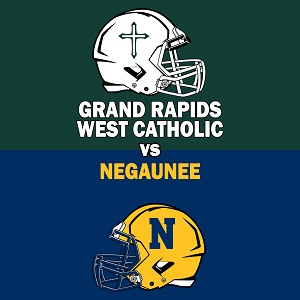 GRAND RAPIDS WEST CATHOLIC
GRAND RAPIDS WEST CATHOLIC
Record/rank: 12-1, No. 1
Coach: Landon Grove, first season (12-1)
League finish: Tied for first in O-K Blue
Championship history: Six MHSAA titles (most recent 2017), two runner-up finishes.
Best wins: 33-14 over No. 2 Clinton in Semifinal, 50-24 over No. 8 Constantine in District Final, 36-18 over Hudsonville Unity Christian, 28-20 over Division 4 No. 5 Edwardsburg.
Players to watch: QB Bernie Varnesdeel, 6-1/192 sr. (1,424 yards/20 TDs passing); RB/OLB Timmy Kloska, 6-0/220 sr. (2,158 yards/35 TDs rushing, 52 tackles/12 sacks); WR/DB Ryer Snow, 6-4/180 jr. (510 yards/7 TDs receiving, 75 tackles/12 sacks/4 interceptions); RB/SL/LB Charlie DeBruyn, 6-0/170 jr. (102 tackles/15 sacks).
Outlook: West Catholic last left Ford Field with a fifth-straight championship in 2017, and the Falcons are making their return with their statistically-strongest offensive and defensive units since that season. DeBruyn helps key a defense with 79 sacks total – junior Ethan Stoner adds another 10 to those leaders listed above – and junior Josh Mitchell (39 tackles) starts on both lines. Kloska is the name most know – he made the all-state first team last season, and his 35 rushing touchdowns qualify for the MHSAA record book. The team’s only loss came 28-20 to Fruitport in Week 7, and the Falcons came back with two shutouts over their next three games and last week limited a Clinton offense averaging 41 points per game to just 14.
NEGAUNEE
Record/rank: 13-0, No. 3
Coach: Paul Jacobson, 23rd season (177-69)
League finish: First in Western Peninsula Athletic Conference Copper
Championship history: Division 6 champion 2002, Class CC runner-up 1991.
Best wins: 13-12 over No. 5 Reed City in Semifinal, 18-12 (Regional Final) and 24-6 over Gladstone, 19-14 over Division 8 No. 4 Iron Mountain.
Players to watch: WR/DB/K/P Phil Nelson, 6-1/185 sr. (326 yards/2 TDs receiving, 39-47 XP/2 FG kicking); RB/DB Kai Lacar, 5-11/185, jr. (1,233 yards/17 TDs rushing, 4 interceptions); WR/LB Niko Lukkarinen, 6-0/215 sr. (1,174 yards/19 TDs rushing); OL/DL Drake Spickerman, 5-11/225 sr.
Outlook: The Miners opened with a close win over Iron Mountain and advanced with one-score victories the last two weeks, but absolutely dominated in between. They didn’t allow a point from Week 8 through the District Final, and total have given up only 148 yards and 6.7 points per game this fall. Senior Easton Palomaki has added another 509 yards and 13 touchdowns on the ground as total Negaunee has rushed for 3,400 and 58, respectively. Sophomore quarterback Ty Jacobson has kept defenses honest with 580 yards and seven touchdowns through the air. Nelson made the all-state second team as a specialist last season, and in addition to kicking and punting he’s also returned three punts for touchdowns this fall.
Division 7
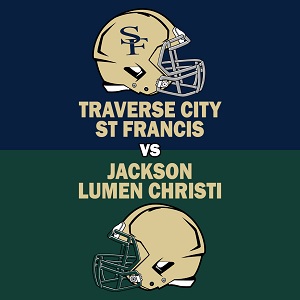 TRAVERSE CITY ST. FRANCIS
TRAVERSE CITY ST. FRANCIS
Record/rank: 13-0, No. 2
Coach: Josh Sellers, 13th season (145-19)
League finish: First in Northern Michigan Football Conference Legends
Championship history: Six MHSAA titles (most recent 2009), four runner-up finishes.
Best wins: 53-8 over No. 5 New Lothrop in Semifinal, 63-0 over No. 8 Ithaca in Regional Final, 42-7 over No. 10 Lawton, 42-35 over No. 4 Jackson Lumen Christi, 45-20 over Division 5 No. 7 Detroit Country Day
Players to watch: QB/DB Wyatt Nausadis, 6-4/210 sr. (1,145 yards/19 TDs passing, 1,007 yards/11 TDs rushing); RB/DB Burke Flowers, 5-11/175 jr. (699 yards/7 TDs rushing, 347 yards/7 TDs receiving); RB/LB Joey Donahue, 6-2/215 sr. (563 yards/14 TDs rushing, 105 tackles/13 tackles for loss); RB/LB Garrett Hathaway, 6-2/220 sr. (851 yards/17 TDs rushing, 4 TDs receiving, 64 tackles).
Outlook: The Gladiators have mostly dominated on their way back to Ford Field for the first time since finishing Division 7 runner-up in 2020; their only close game other than the Week 2 win over Lumen Christi was a 16-pointer over Benzie Central in the District Final after previously defeating Benzie 49-12 in Week 3. Nausadis was an all-state receiver last season and has taken over for a graduated all-state quarterback with the best possible results. Donahue also made the all-state first team last season and leads a defense that’s raised its game even more during the playoffs giving up only 34 points total over four wins.
JACKSON LUMEN CHRISTI
Record/rank: 10-3, No. 4
Coach: Herb Brogan, 43rd season (394-94)
League finish: Second in Interstate 8 Athletic Conference
Championship history: 11 MHSAA titles (most recent 2018), three runner-up finishes.
Best wins: 20-7 over No. 7 Napoleon in Semifinal, 7-6 over No. 10 Lawton in Regional Final, 35-0 over No. 3 Hudson in District Final, 19-14 over Parma Western.
Players to watch: FB/LB Devian Franklin, 6-1/210, sr. (438 yards/11 TDs rushing); RB/DB Derrick Walker, 6-0/195 sr. (1,159 yards/15 TDs rushing); QB/LB Joe Lathers, 6-1/190 sr. (844 yards/7 TDs passing, 743 yards/17 TDs rushing); TE/LB Conor Smith, 6-1/210 sr. (Lathers’ passing does not include Semifinal.)
Outlook: Lumen Christi returns to Ford Field for the first time since finishing Division 7 runner-up in 2019. Freshmen who made that trip are now seniors, and the backfield features three veterans in Lathers, Franklin and Walker. They helped the Titans pulled off the rare feat of starting 0-3 but making the final weekend of the season, but those three losses also require context – they came 12-7 to No. 5 New Lothrop, 42-35 to St. Francis and 24-21 to Division 4 No. 8 Hastings. The defense, keyed in part by Smith, Franklin and Lathers at linebacker, has given up a combined 20 points over four playoff games and only 11.5 points per game all season. Brogan sits third on the all-time state football coaching wins list.
Division 8
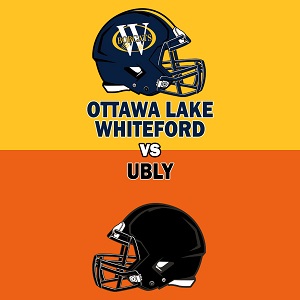 OTTAWA LAKE WHITEFORD
OTTAWA LAKE WHITEFORD
Record/rank: 13-0, No. 2
Coach: Todd Thieken, first season (13-0)
League finish: First in Tri-County Conference
Championship history: Division 8 champion 2017, runner-up 2016.
Best wins: 44-6 over Clarkston Everest Collegiate in Semifinal, 38-26 over White Pigeon in Regional Final, 56-19 over Riverview Gabriel Richard in District Final, 50-14 over Erie Mason.
Players to watch: QB/DB Shea Ruddy, 5-11/170 sr. (1,129 yards/19 TDs passing, 725 yards/17 TDs rushing, 64 tackles); RB/DB Hunter DeBarr, 5-11/150 jr. (1,116 yards/10 TDs rushing, 361 yards/7 TDs receiving, 59 tackles); RB/LB Jake Iott, 6-1/180 jr. (1,121 yards/21 TDs rushing, 190 tackles/14 tackles for loss); TE/DB Ryin Ruddy, 6-1/170 jr. (279 yards/8 TDs receiving, 115 tackles/4 interceptions).
Outlook: Whiteford built back to the Semifinals last season and took the next step this fall winning every game by double digits and 49-12 on average. Shea Ruddy made the all-state second team at quarterback last year and has helped the Bobcats top 50 points seven times including during the first two rounds of the playoffs. His 19 touchdown passes are a school record, as are Iott’s 190 tackles. Thieken previously served as head coach from 2005-10 at Evergreen, Ohio, and more than 25 seasons as an assistant before taking over the Whiteford varsity this fall. Junior fullback Drew Knaggs is another reliable option on offense; he’s run for 524 yards and seven touchdowns.
UBLY
Record/rank: 13-0, No. 1
Coach: Eric Sweeney, third season (35-0)
League finish: First in Greater Thumb Conference East
Championship history: Division 8 runner-up 2020, Division 7 runner-up 2008.
Best wins: 41-14 over No. 4 Iron Mountain in Semifinal, 49-7 over No. 8 Fowler in Regional Final, 49-14 over No. 5 Saginaw Michigan Lutheran Seminary in District Final, 42-0 over Harbor Beach.
Players to watch: QB/DB Evan Peruski, 5-11/170 jr. (312 yards/6 TDs passing, 1,165 yards/20 TDs rushing, 46 tackles); RB/LB Aiden Mackowiak, 5-10/175 sr. (943 yards/13 TDs rushing, 121 tackles); RB/DB Mark Heilig, 5-10/175 sr. (1,354 yards/29 TDs rushing, 77 tackles); RB/DE Seth Maurer, 5-11/190 jr. (714 yards/12 TDs rushing, 59 tackles).
Outlook: Ubly can argue it’s been the most dominant team in Michigan, relative to division, this fall. The Bearcats’ closest game was last week’s 27-point win over Iron Mountain, and their average score this fall is 49-7. On defense, no opponent has scored more than 16 points and three have put up more than seven. The offense has scored at least 41 points in every game. Peruski started at quarterback as a freshman at Ford Field in 2020, and he earned an all-state honorable mention last season. Heilig and Mackowiak are among others who saw action in that last championship game appearance, and Mackowiak also earned all-state honorable mention last season, at linebacker. Junior Brett Mueller is another important option on offense; he made the all-state first team last season and this fall has connected on 84 of 87 extra-point attempts and a field goal.
MHSAA.com's weekly “1st & Goal” previews and reviews are powered by MI Student Aid, a part of the Office of Postsecondary Financial Planning located within the Michigan Department of Treasury. MI Student Aid encourages students to pursue postsecondary education by providing access to student financial resources and information. MI Student Aid administers the state’s 529 college savings programs (MET/MESP), as well as scholarship and grant programs that help make college Accessible, Affordable and Attainable for you. Connect with MI Student Aid at www.michigan.gov/mistudentaid and find more information on Facebook and Twitter @mistudentaid.

